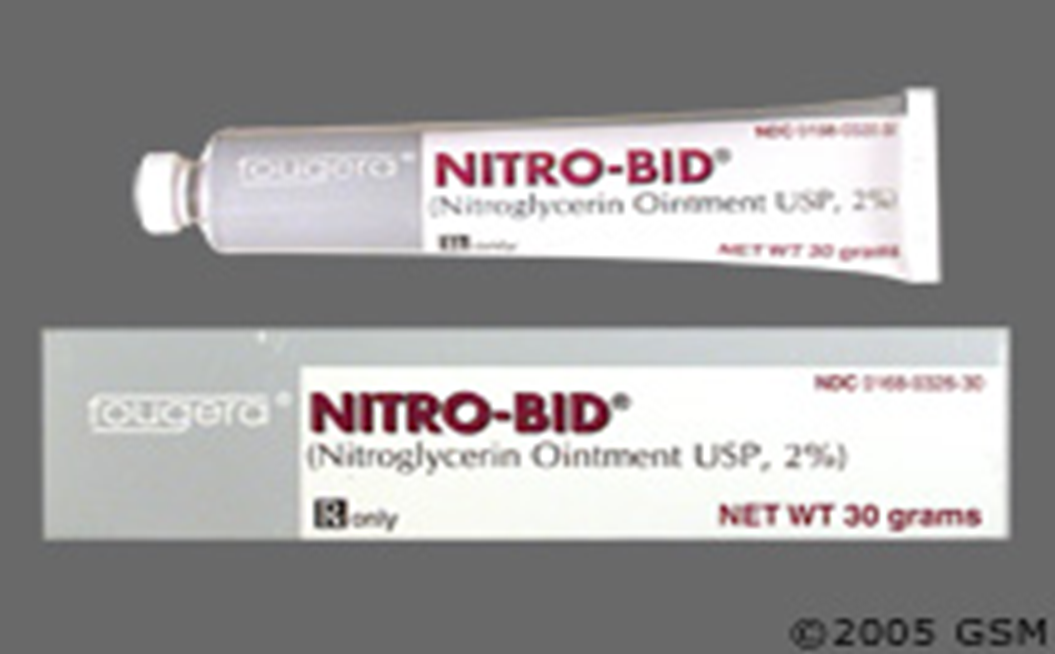Organic nitrates and nitrites:
Inorganic nitrates are ineffective
Classification:
- Short-acting nitrates:
- Amyl nitrite (inhalation)
- Nitroglycerine (SL)
- Isosorbide dinitrate (SL)
- i.v. nitroglycerin
- Long-acting nitrates:
- Isosorbide dinitrate or
- mononitrate (Oral)
- Transdermal patches
Pharmacokinetics:
Absorption: nitrates are rapidly absorbed from buccal membrane, GIT, and bronchioles.
Metabolism: in the liver:
- If given oral → extensive first-pass hepatic metabolism (oral bioavailability <10%).
- If given sublingual → no first-pass metabolism → high bioavailability.
Excretion: via the kidney.
Mechanism of action:
acts by causing systemic venodilation by causing liberation of the free radical nitric oxide (NO) which is identical to the endothelial derived relaxing factor (EDRF) → ↑ cGMP → ↓ Ca2+ influx into the vascular sm ms → VD (more on the veins).
Pharmacological effects:
CVS:
-
Blood vessels: VD of the venous (and to lesser extent to the arterial) side leading to ↓ preload . So, Reducing myocardial wall tension and oxygen requirements
Dilating the epicardial coronary vessels leading to increased coronary blood flow
- Increasing blood flow in collateral vessels
- VD of the arteries in the face and neck leading to flushing.
- VD of meningeal arteries leading to throbbing headache.
-
Heart: Reflex tachycardia (in high dose) 2ry to ↓ BP.
-
BP: High doses cause ↓ in both systolic and diastolic BP.
Smooth ms:
- relaxation of bronchial, GIT, uterine, and biliary sm ms. Respiration:
- reflex tachypnea (↑ resp rate) due to hypotension. Blood:
- Methemoglobinemia in high doses due to oxidation of Hb into met-Hb.
Therapeutic uses:
1-Angina pectoris:
- Nitrates are used for treatment of all types of angina both for relieving the acute attack and for prophylaxis.
These effects will lead to: A-Reduction of myocardial O2 demand through:
- Venodilatation → ↓ venous return (preload) .
- Arteriolodilatation → ↓ peripheral resistance (afterload). B-Enhancement of myocardial perfusion through:
- Coronary VD.
- Redistribution of blood from large epicordial vessels to ischemic subendo-cardial vessels.
2-Myocardial infarction: to ↓ the area of myocardial damage. 3-Acute heart failure: to ↓ preload and afterload. 4-Treatment of cyanide poisoning: cyanide has high affinity for metHb more than normal Hb. 5-Biliary colic. 6-Management of constriction ring during labor.
Side effects:
-
Hypotension and reflex tachycardia: may aggravate angina.
-
Throbbing headache: with nitroglycerin, due to VD of meningeal arteries.
-
Flushing of the face.
-
Tolerance to its effect: with long acting preparation due to:
- Depletion of sulfhydryl (-SH) containing enzymes necessary for liberation of NO from nitrates → ↓ formation of NO → ↓ VD effect.
- Reflex sympathetic activation (due to hypotension), this will cause VC.
- Prevention of tolerance: make a daily nitrate-free interval (8-10–12 h) to give chance for the SH- containing enzymes to regenerate.
- During this period, give another anti-anginal drug (e.g. beta-blocker or CCBs).
-
Methemoglobinemia in high doses (rare).
-
Never to be combined with other drugs causing vasodilation (Viagra®) or hypotension - would result in irreversible hypotension
Precautions during nitrate therapy:
- Tablet should be held under tongue until dissolved. Avoid eating, drinking, or smoking until tablet is dissolved.
- Advise patient to sit down.
- Relief should occur in 1 to 3 minutes
- Use the smallest effective dose to avoid hypotension and reflex tachycardia.
- The patient should consult his doctor if anginal pain does not improve after taking 3 SL tablets of NG during 15 min (may be MI). May be repeated every 5 minutes for 3 doses.
- Nitroglycerine tablets should not be put in direct sunlight or with cotton .
- The expiry date (60 days) should be checked (active tablets have burning taste).
- Sudden withdrawal may cause acute MI.
Sustained Released Tablet
Administer dose 1 hour before or 2 hours after meal with a full glass of water for faster absorption.
Nitroglycerine Patch
- Place the patch on a hairless area of chest or upper arm each day.
- Move patch to a different place on your body each day to prevent skin irritation.
- Remove the patch for 8 to 12 hours each night and put on a fresh patch each day.
- Patches – takes 40 minutes to an hour to start working
- Place the patch on a hairless area of chest or upper arm each day.
- Move patch to a different place on your body each day to prevent skin irritation.
- Remove the patch for 8 to 12 hours each night and put on a fresh patch each day.
- Patches – takes 40 minutes to an hour to start working

Nitroglycerine Ointment

Acute Coronary Syndrome
-
The resulting vasodilation of veins and peripheral and coronary arteries may reduce excessive cardiac preload and afterload.
-
Route: Intravenous nitroglycerin is preferred
-
Indications: The first 24 to 48 hours of acute MI and heart failure , large anterior MI, persistent ischemia , or hypertension.